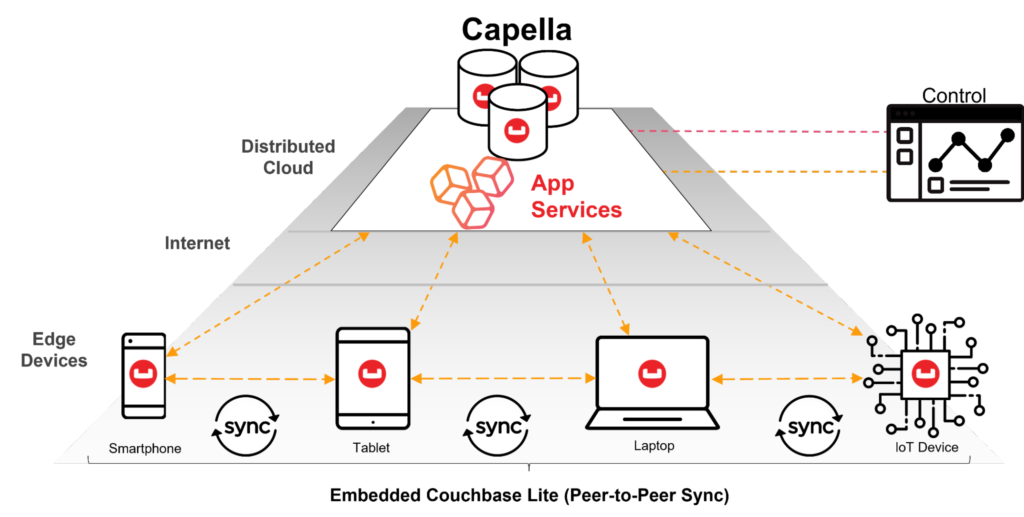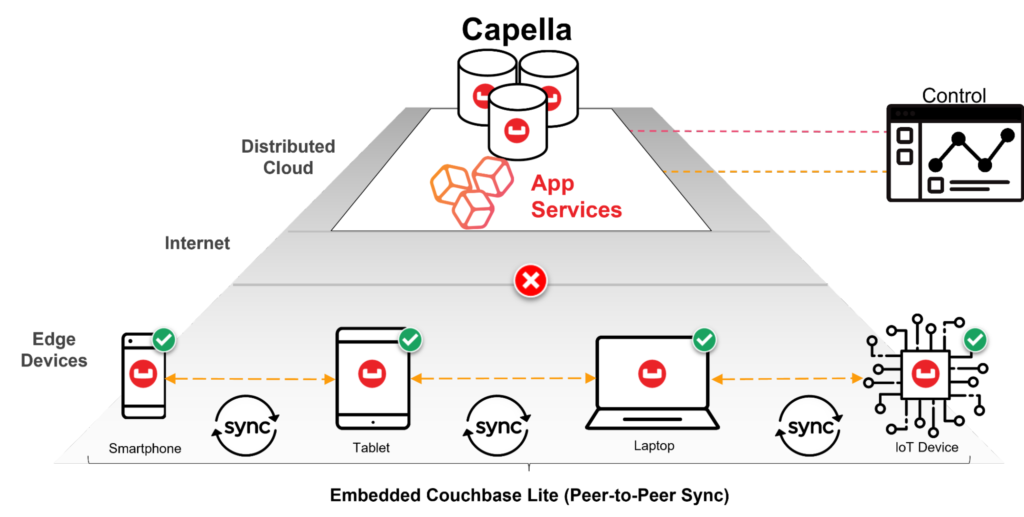Consider the following questions:
-
- Are the mobile apps that you deliver suffering poor adoption or bad reviews on app stores?
- Can the mobile apps that you build be used anywhere, including the middle of nowhere?
- Are you losing business due to app downtime?
It’s all about data
One thing that ties these questions together is data, or more specifically, how your mobile app is designed to access and use data. Of course all apps need data in order to operate, but where you persist and process it can have huge implications on how you answer these types of questions.
If you’re building mobile and edge apps that only get their data from the cloud, they depend on the internet, and so become subject to its inherent unreliability. If the internet is slow, so is the experience for your app users, making them frustrated and more likely to abandon. And if internet connectivity is lost – or altogether nonexistent – those apps can’t operate at all, rendering them useless.
Slowness and downtime are more than an inconvenience, they can have a dramatic impact on the bottom line. Take retail apps, where even short periods of downtime can be incredibly costly. Or healthcare apps, where speedy access to accurate data is critical for good patient outcomes.
These examples are not niche cases, they are part of a growing class of applications that require high speed and 100% uptime as a core tenet, with no tolerance for latency or outages, period.
If you have similar requirements, how do you eliminate internet dependencies and build mobile and edge apps that are fast and available regardless of network connectivity?
You must approach the app development process with an “offline first” mindset.
What is an “offline first” app?
The term “offline first” describes a mobile app that can operate without requiring an internet connection, essentially providing core functionality while completely offline, hence the term.
The offline first mindset is one that assumes there will be network connectivity issues and so develops around them. Deciding where to store and process the data that your app requires is a key factor.
The database you use makes a difference
One assumption might be to simply embed a database to the mobile app itself, that is, store and process the data locally on the device running the app using an embedded database such as SQLite. This certainly achieves the requirement to remove internet dependencies – the app has the data it needs to operate because it is stored locally, enabling it to work without network connectivity.
But simply embedding the database to the application is not enough. For multi-user mobile apps where data changes rapidly, it must be securely shared across the app ecosystem, which requires data synchronization. Without this essential capability, apps risk displaying and acting on stale, inaccurate or unauthorized information.
What’s needed is a database built for offline first mobile and edge applications, one that can be embedded in apps to eliminate internet dependencies, but that can also synchronize data between the cloud and other devices automatically when connectivity exists.
Couchbase – tailor made for offline first database
Couchbase provides a developer-friendly mobile database that our customers use to build offline first apps that are impervious to internet slowness or outages.
The Couchbase mobile database stack includes:
-
- Couchbase Capella – A fully managed cloud NoSQL database-as-a-service (DBaaS) with support for SQL, search, analytics and eventing.
- Capella App Services – Fully managed services for bidirectional sync, authentication and access control for mobile and edge apps.
- Couchbase Lite – An embedded NoSQL mobile database with SQL, search, eventing and broad mobile platform support.
Capella App Services automatically synchronizes data between the Capella DBaaS and Couchbase Lite embedded clients:

By storing and processing data locally, embedded devices continue to operate even without internet connectivity. And embedded devices in close proximity can still sync while offline leveraging peer-to-peer sync, a feature unique to Couchbase:

Couchbase offline first customer use cases
Couchbase has been used by many customers to meet requirements for fast resilient mobile and edge apps that work regardless of internet connectivity, here are a few fascinating examples.
BackpackEMR
BackpackEMR provides apps for mobile clinics in remote and underserved areas where there is little to no internet. They embed Couchbase to the apps that run on tablets, allowing them to operate in a completely disconnected mode, and they leverage built-in synchronization to ensure everyone sees current and accurate information. Clinicians get access to patient histories updated in real time, and they can instantly and securely share patient data across the clinic – from registration to vitals, labs, exam rooms, and even through to the pharmacy. The app tracks treatments, referrals and recommendations for follow up appointments, ensuring patients are up to date on their care.
By leveraging Couchbase to ensure their apps work anywhere, all the time, BackpackEMR is helping provide vital healthcare for areas of the world that need it most. Learn more about how BackpackEMR uses Couchbase here.
Hammerhead
Hammerhead provides a next-generation cycling computer called Karoo 2, designed specifically for cyclists to help them do structured workouts, follow routes and get the most out of every ride. A critical feature of Karoo 2 is its offline first capability, as cyclists are not typically connected to a network during rides. The app tracks rider and riding conditions using GPS, a speedometer, a heart rate monitor and barometric sensors. A Couchbase embedded database and secure sync enables it to provide precise turn-by-turn navigation guidance regardless of internet connectivity.
Couchbase helps Hammerhead deliver on their promise to empower all people to unlock their athletic potential through cycling. Read more about how Hammerhead uses Couchbase here.
SyncThink
So far we’ve looked at customer use cases in healthcare and in sports, now we’ll look at a customer use case that combines healthcare AND sports. SyncThink provides the EYE SYNC solution to major athletic teams for concussion assessment on the playing field. The solution uses a VR headset that tracks eye movement and a paired tablet running an app with Couchbase embedded, allowing it to work even where network connectivity might be slow or unavailable, such as in a football stadium or locker room. Since seconds count in the case of brain injury players need to be assessed for concussion immediately, so the ability to run without an internet connection was a top requirement for SyncThink, and Couchbase was able to deliver.
SyncThink relies on Couchbase to improve outcomes for sports injuries through real time concussion assessment, learn more about their use case here.
Try it for yourself
Couchbase makes it easy to develop offline first apps that are always fast and always on, see for yourself by taking advantage of the Couchbase Capella Free Trial.